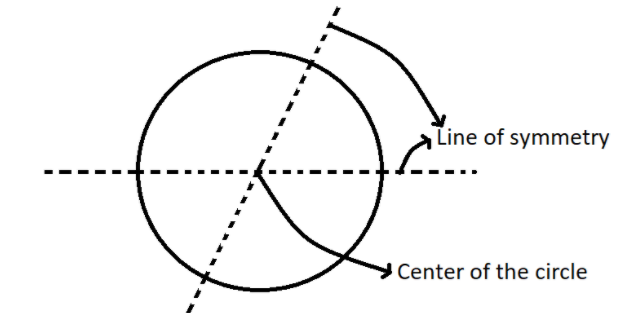
How many lines of symmetry does a circle have?
Answer
555k+ views
Hint: Here, we have to use the concept of the line of symmetry. Line of Symmetry is an imaginary line or axis that divides a shape or figure into two exactly similar or identical halves. The line of symmetry generally passes through the centre of the shape.
Complete step-by-step answer:
We know that there are infinite numbers of lines passing through the centre of the circle. Any straight line which passes through the centre of the circle always divides the circle into two similar or identical halves. It means all the infinite numbers of lines which pass through the centre of the circle are the lines of symmetry of the circle.

Therefore, there are infinite numbers of lines of symmetry a circle have.
Note: We know that if a shape or the object has a line of symmetry then it is considered that the object or shape is symmetrical in nature. Nature uses symmetry to make things beautiful. Symmetry is often seen every day by people of all ages in nature. Symmetry that we see everyday in nature is most often Bilateral Symmetry. This means that the two halves of an object are exact mirror images of each other.
Generally, there are three types of Symmetry
(i)Radial symmetry: The organism looks like a pie.
(ii)Bilateral symmetry: They are based on the axis symmetry; on both sides of the axis an object looks roughly the same.
(iii)Spherical symmetry: If an object is cut through its center, the resulting parts look the same.
Complete step-by-step answer:
We know that there are infinite numbers of lines passing through the centre of the circle. Any straight line which passes through the centre of the circle always divides the circle into two similar or identical halves. It means all the infinite numbers of lines which pass through the centre of the circle are the lines of symmetry of the circle.

Therefore, there are infinite numbers of lines of symmetry a circle have.
Note: We know that if a shape or the object has a line of symmetry then it is considered that the object or shape is symmetrical in nature. Nature uses symmetry to make things beautiful. Symmetry is often seen every day by people of all ages in nature. Symmetry that we see everyday in nature is most often Bilateral Symmetry. This means that the two halves of an object are exact mirror images of each other.
Generally, there are three types of Symmetry
(i)Radial symmetry: The organism looks like a pie.
(ii)Bilateral symmetry: They are based on the axis symmetry; on both sides of the axis an object looks roughly the same.
(iii)Spherical symmetry: If an object is cut through its center, the resulting parts look the same.
Recently Updated Pages
Master Class 8 Social Science: Engaging Questions & Answers for Success

Master Class 8 Maths: Engaging Questions & Answers for Success

Master Class 8 Science: Engaging Questions & Answers for Success

Class 8 Question and Answer - Your Ultimate Solutions Guide

Master Class 8 English: Engaging Questions & Answers for Success

Master Class 11 Economics: Engaging Questions & Answers for Success

Trending doubts
What is BLO What is the full form of BLO class 8 social science CBSE

Citizens of India can vote at the age of A 18 years class 8 social science CBSE

Full form of STD, ISD and PCO

Right to vote is a AFundamental Right BFundamental class 8 social science CBSE

Summary of the poem Where the Mind is Without Fear class 8 english CBSE

What are gulf countries and why they are called Gulf class 8 social science CBSE





